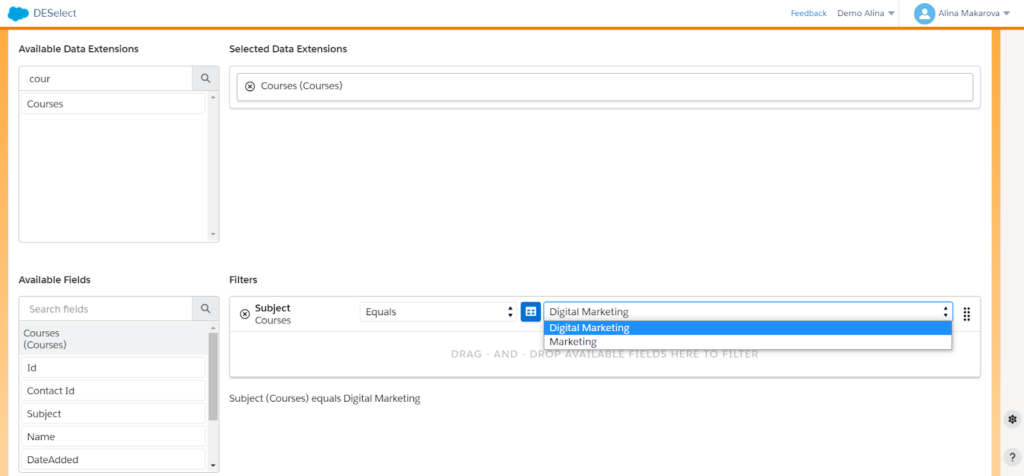
Audience personalization in Salesforce Marketing Cloud heavily relies on the UNION SQL (Structured Query Language) clause for data manipulation, analysis, and segmentation. This complex code has been a language many creative marketers struggle to master, making it the “French” of marketing ops.
What better way to understand how DESelect solves this problem other than demo videos? Keep reading to get to the video content below.
The Traditional Importance of UNION and SQL Overall
SQL is the language of Marketing Cloud. Without a strong understanding, users and teams typically face several challenges, including:
- Data Retrieval: Difficulty accessing and using data needed to make informed decisions
- Data Analysis: Absent UNION or SQL knowledge altogether, users struggle to segment, aggregate, and filter data to gain necessary insights into customer behavior
- Data Segmentation: Marketers use SQL to segment their audience based on various criteria, such as behavior, demographics, and purchase history
- Automated Campaigns: Marketers rely on SQL to define the conditions that trigger automated, personalized campaigns
- Data Management: SQL allows users to import, export, and manipulate large amounts of data
Often, teams rely on technical marketers and IT professionals to fill these roles. However, too great a reliance limits the effectiveness of Salesforce Marketing Cloud’s capabilities and distracts these employees from primary functions, leading to reduced output and efficiency across the entire team.
Worst case scenario: marketers do not know enough about SQL to create correct UNION sequences. Still, they have to try anyway, leading to hours of lost productivity waiting on IT ticket resolution to iron out mistakes.
How Marketing Cloud Architects Make Life Easier for Marketers and Limit Mistakes
Recreational bowlers are all too familiar with lane bumpers, designed to prevent novices from spending every turn helplessly watching gutterball after gutterball. CRM architects can set similar safeguards in Marketing Cloud to ensure all marketers effectively segment without UNION or SQL errors.
Some effective tactics:
- Training: Frequent training sessions help users become more familiar with SQL and practical use cases. Supplemental training materials, such as tutorials and guides, help users learn at their own pace.
- Templates: Create pre-built templates as a starting point for campaigns, segments, and other tasks. These templates should be designed to minimize the need for manual data manipulation and SQL coding.
- Process Documentation: Develop and share clear process documentation that explains the steps to execute everyday tasks within Salesforce Marketing Cloud.
- Validation Rules: Implement validation rules to help prevent data errors and ensure data entry in a consistent, correct format. This reduces the risk of data quality issues and improves the accuracy of data-driven insights.
- Quality Assurance: Implement a review-and-approve workflow or automated quality assurance process to ensure that all campaigns, segments, and data manipulations are reviewed and approved by an experienced user before being executed.
By following these strategies, architects help ensure Marketing Cloud users of all skill sets can execute their tasks effectively and confidently, reducing the risk of errors and mistakes.
DESelect: The Bowling Bumpers of Marketing Cloud
With DESelect Segment, Marketing Cloud users of all backgrounds no longer worry about UNION or SQL when creating audiences. The tool provides intuitive drag-and-drop features, replacing the heavy code otherwise required.
With this ease comes peace of mind for Marketing Cloud admins, as DESelect provides many of the guideposts mentioned above. Below are two of the most popular features that ensure creative marketers quickly and accurately create their audience segmentations for campaigns.
Data Sets
With data sets, an experienced technical marketer or admin intimately familiar with the data model can prepare a data set with multiple data extensions and set the relationships between each. This way, marketers can segment based on multiple data extensions without necessarily knowing how to connect them – and still get the data needed.
To connect data extensions, you can create a custom relation in the DESelect admin panel or import one from an external source. Marketing Cloud and DESelect expert Markus Dang demonstrates a use case connecting sample Orders with Products Ordered.
Once the relations have been defined across data extensions, you are ready to define the data set.
To summarize, data sets give marketers pre-filled segmentation tailored to the common campaign requirements of your organization. With these templates in hand, marketers eliminate much of the time requirements and prevent UNION SQL errors.
Picklists
Another popular DESelect admin feature, picklists, simplify data entry for marketers and remove the room for typos when creating segmentation filters. Picklists also reduce the need to remember complex or technical values, further protecting against mistakes.
Marketers can then use picklists in all subsequent segmentations involving the selected data extension. Picklists can be enabled or disabled depending on current conditions.
Once defined, admins can relabel values to make for easier use. Once set up, marketers will see a dropdown list to choose from, enabling faster, more accurate segmentations.

In other words, marketers don’t need to know the values beforehand because DESelect retrieves them.
Conclusion
With Marketing Cloud already such a complex platform, providing guard rails helps ensure creative marketers quickly get their campaigns in front of the right audience without bogging down technical teams with requests and distractions.
We will cover more DESelect admin features in Part Two. In the meantime, if you want to learn more, see how Pon Automotive uses DESelect data sets (and other built-in templates) to speed up campaign operations and onboard new employees quicker.









